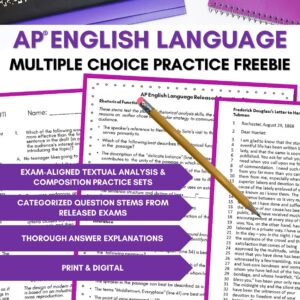AP English Language multiple choice test prep can be miserable, but you can spread out the misery or even eliminate it. Because I am a nerd, I actually LIKE getting students ready for the multiple choice section of the AP exam. The clean-cut nature of time management and test-taking strategies is so far removed from what we do on a daily basis that I actually find it refreshing. Here’s a handful of my best tips and tricks:

TIP #1: Begin each AP Lang class with an AP Language multiple choice bell ringer.
Students answer one to four questions based on one short passage. They answer the question(s) and then write a short defense. When students can articulate why they chose or eliminated as they did, their chances of picking the right one improve significantly.
TIP #2: Teach students how question stems and answer choices are designed.
After reading any non-fiction piece, guide students through the design of an AP-Lang style multiple choice question. You can learn how to do that in this resource. Multiple choice is a lot less intimidating when students have been on the design side.
TIP #3: Make going over AP Language multiple choice answers a game—a really fun one!
Five Corners lets students talk each other into and out of their answers. They’re out of their desks practicing their persuasion skills, and the teacher just guides the process and keeps the volume to a dull roar. Read more about the way I make it work.
TIP #4: Don’t worry about speed for the AP Language exam until March.
Concern yourself with their close reading skills and composition skills until then. That doesn’t mean they should get an hour to answer ten questions, but the super-tight time constraints don’t need to be put on until the spring.

Want to help students understand the way questions are designed? This freebie would be a great way to review stems and format.
TIP #5: Beginning in March, work on pacing.
On the exam, they will have 60 minutes answer 23-25 reading questions and 20-22 writing questions.
Work on quick elimination. Three of the five answers should be relatively “easy” to eliminate, but there will always be one that is a close second, a not-quite-there distractor that, if chosen, is evidence of (usually) a misreading of the text. This is also known as a foil. If students can get faster at eliminating the three “easy” ones, then spending one minute(ish) on a question is achievable.
Urge students not to get bogged down in EXCEPT questions. I have a bit of background in question design, and I have such an issue with College Board and ETS using this format. Here’s what I’m talking about:
In the context of the passage, all of the following phrases refer to the same idea EXCEPT (A)“revolutionary methods” (line 6) (B)“militant methods” (line 30) (C)“the only means we consider open to voteless persons” (lines 49–50) (D)“the proper and the constitutional and the practical way of getting their grievance removed” (lines 55–57) (E)“some of the antiquated means by which men in the past got their grievances remedied” (lines 77–78)
Students cannot eliminate answer choices the same way, and the format goes against the way our brains make choices (and the way we have trained our students to take standardized tests). In order to check their answers, students have to plug in five choices, not just one. I hate ‘em, and I hate how much time they eat up. In order to give due time to an EXCEPT question, a student has to sacrifice one or two other questions, all of which carry the same weight. Practice devoting no more than one minute to these questions.

